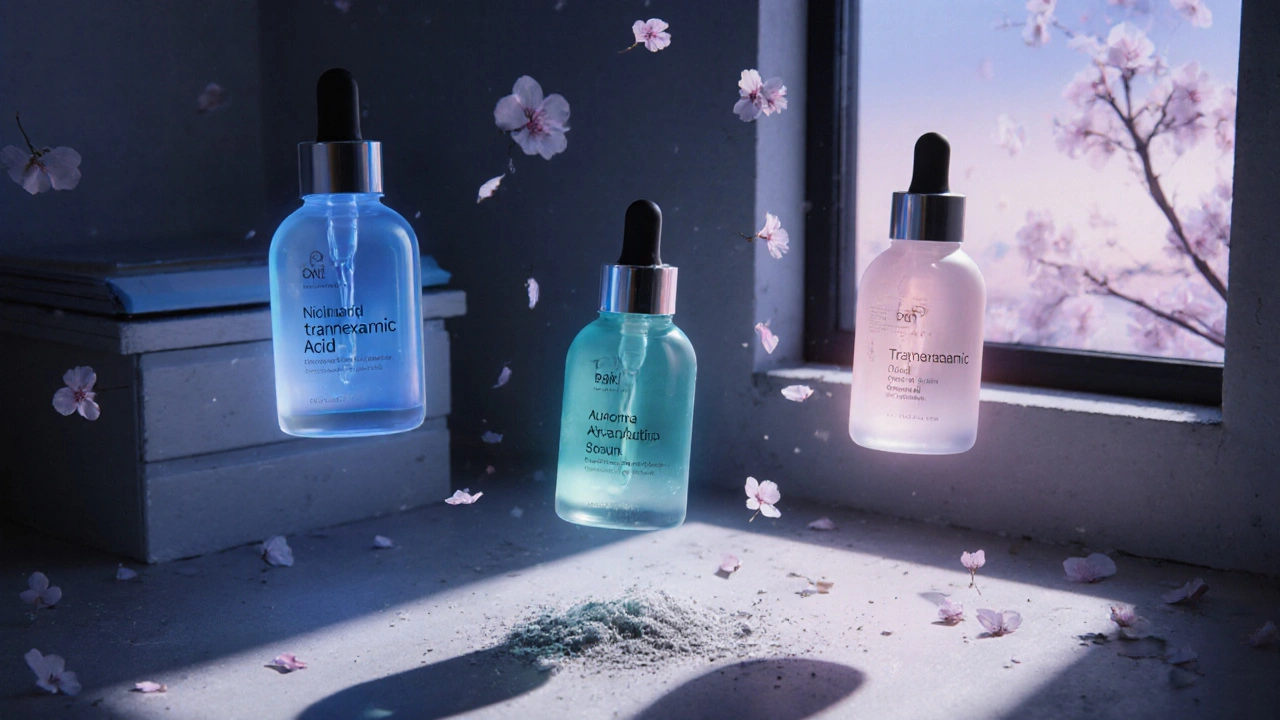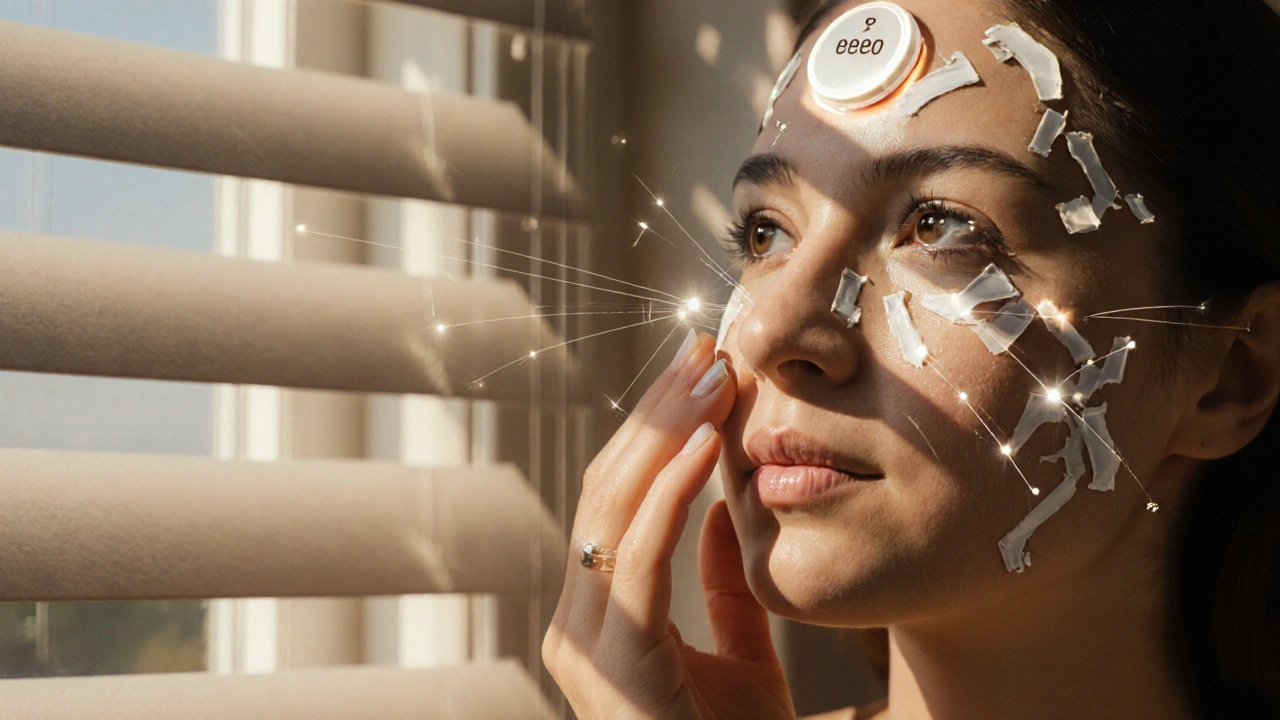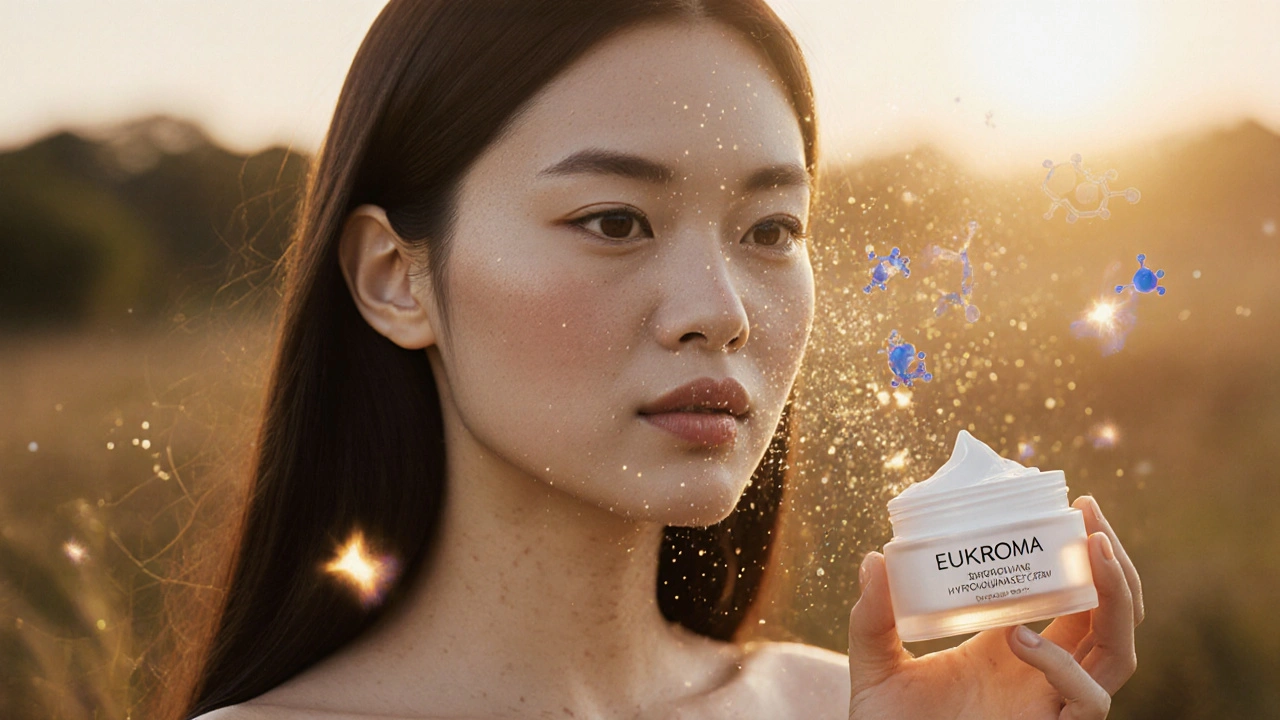Skin Lightening Option Selector
Find Your Best Skin Lightening Alternative
Answer these questions to get personalized recommendations based on your skin concerns and preferences
Eukroma Cream is one of the most talked-about skin lightening treatments for dark spots, melasma, and post-acne discoloration. It contains 4% hydroquinone, a potent ingredient that reduces melanin production. But it’s not the only option-and it’s not without risks. If you’re considering Eukroma, you should know what else is out there, what works just as well, and what might be safer for long-term use.
How Eukroma Cream Works
Eukroma Cream stops skin cells from making too much pigment. Hydroquinone blocks an enzyme called tyrosinase, which is needed to create melanin. That’s why it’s effective for melasma, sun spots, and age spots. Many users see results in 4 to 8 weeks, especially when paired with sunscreen. But here’s the catch: hydroquinone is not meant for daily, lifelong use. The FDA has flagged long-term use as potentially dangerous, and the European Union banned it in cosmetics entirely.
Side effects are common. Skin irritation, redness, and dryness happen in up to 30% of users. In rare cases, prolonged use can cause ochronosis-a blue-black discoloration that’s permanent and hard to treat. That’s why dermatologists usually prescribe it for no more than 3 to 6 months at a time.
Why People Look for Alternatives
Most people don’t want to risk permanent skin damage. Others can’t get a prescription. Some want something natural. And many just want to avoid a drug that’s been restricted in other countries. The search for alternatives isn’t about cutting corners-it’s about finding a balance between results and safety.
Tranexamic Acid: A Prescription-Grade Alternative
Tranexamic acid was originally used to reduce heavy menstrual bleeding. Then dermatologists noticed it helped with melasma. Now it’s a top-tier alternative to hydroquinone. Studies show it works as well as 4% hydroquinone for melasma, with far fewer side effects.
It blocks UV-induced pigmentation at the cellular level, without killing pigment cells. You’ll find it in prescription creams like Tranexamic Acid 3% + Kojic Acid 2% combinations. It’s also in oral tablets for severe cases. Unlike hydroquinone, there’s no risk of ochronosis. It’s safe for longer use-some patients use it for over a year with no issues.
Downside? It’s not available over the counter in the U.S. You need a prescription. But if you’ve tried hydroquinone and had bad reactions, this is your next best step.
Niacinamide: The Gentle, Science-Backed Option
Niacinamide (vitamin B3) is everywhere now-serums, moisturizers, toners. But don’t dismiss it as just another trendy ingredient. Clinical trials prove it reduces hyperpigmentation. One 2019 study in the Journal of Clinical and Aesthetic Dermatology showed 4% niacinamide reduced dark spots by 35% in 4 weeks, with no irritation.
It works differently than hydroquinone. Instead of shutting down pigment production, it prevents melanin from transferring to skin cells. That means it fades spots gradually, without the risk of rebound pigmentation. It’s also anti-inflammatory, so it helps with redness and acne-prone skin.
Best part? You can buy it without a prescription. Look for products with 5% niacinamide or higher. Brands like The Ordinary, CeraVe, and Paula’s Choice have affordable, effective options. Use it twice daily, and pair it with sunscreen. Results take 8-12 weeks, but they’re steady and safe.

Azelaic Acid: The Multi-Tasker
Azelaic acid is a natural compound found in grains. In prescription form (15-20%), it’s FDA-approved for both acne and rosacea-and it’s a solid alternative to hydroquinone for pigmentation.
It gently exfoliates, kills bacteria, and reduces melanin production. A 2021 study compared 20% azelaic acid to 4% hydroquinone in patients with melasma. Both improved skin tone, but azelaic acid caused significantly less irritation. It’s also safe during pregnancy, which hydroquinone is not.
Over-the-counter versions (10%) are less potent but still helpful for mild discoloration. Prescription brands like Finacea or Azelex are more effective. It takes 6-12 weeks to see results, but if you have sensitive skin or acne along with dark spots, this might be your best all-in-one solution.
Kojic Acid and Arbutin: Natural Options
Kojic acid comes from fermented rice. Arbutin is a plant-derived compound found in bearberry leaves. Both are natural tyrosinase inhibitors-similar to hydroquinone but milder.
Kojic acid can be irritating and unstable (it breaks down in light). Products need to be stored properly and used with caution. Arbutin, especially in its alpha form, is gentler and more stable. Studies show 7% alpha-arbutin works nearly as well as 4% hydroquinone for fading spots, with minimal side effects.
These are great for people who want to avoid synthetic chemicals. Look for serums or creams with 2-5% arbutin or 1-2% kojic acid. Don’t expect miracles in a week. Consistency matters. Use daily for 3 months, and you’ll see a noticeable difference.
Retinoids: The Long-Term Game Changer
Retinoids-like tretinoin, adapalene, and retinol-aren’t direct lighteners. But they’re powerful allies. They speed up skin cell turnover, which means pigmented cells are sloughed off faster. They also boost collagen and improve skin texture.
A 2020 study in the British Journal of Dermatology found that combining 0.05% tretinoin with 4% hydroquinone gave better results than hydroquinone alone. But even on its own, retinol (over-the-counter) can reduce pigmentation over time.
Start slow: use retinol 2-3 times a week. It causes peeling and dryness at first, but your skin adapts. After 3-6 months, you’ll notice brighter, more even skin. Pair it with niacinamide to reduce irritation. It’s not a quick fix, but it’s one of the most effective long-term strategies.
Comparison Table: Eukroma vs Alternatives
| Product/Ingredient | Strength | Time to See Results | Side Effects | Prescription Needed? | Safe for Long-Term Use? |
|---|---|---|---|---|---|
| Eukroma Cream (Hydroquinone) | 4% | 4-8 weeks | Redness, irritation, risk of ochronosis | Yes | No |
| Tranexamic Acid | 3-5% | 6-12 weeks | Mild dryness | Yes | Yes |
| Niacinamide | 5-10% | 8-12 weeks | Very rare | No | Yes |
| Azelaic Acid | 15-20% | 6-12 weeks | Mild stinging | Yes | Yes |
| Alpha-Arbutin | 2-7% | 8-16 weeks | Minimal | No | Yes |
| Retinol | 0.1-1% | 3-6 months | Peeling, dryness (early use) | No | Yes |

What Works Best for You?
If you have severe melasma or stubborn dark spots, and you’ve already tried OTC products, start with a dermatologist. Prescription tranexamic acid or azelaic acid will give you the fastest, safest results.
If you prefer to avoid prescriptions, niacinamide and alpha-arbutin are your best bets. Use them daily. Be patient. They’re slow, but they’re reliable.
Retinoids are ideal if you’re also dealing with fine lines, acne, or dull skin. They don’t just lighten-they renew.
And if you’ve used hydroquinone before and had a bad reaction? Skip it. Don’t go back. The risks outweigh the benefits.
What You Must Do No Matter What
Sunscreen isn’t optional. Every single one of these treatments fails without it. UV exposure triggers melanin production, undoing any progress you make. Use SPF 30 or higher every day-even indoors. Reapply if you’re outside for more than 2 hours.
Also, avoid harsh scrubs, chemical peels, or DIY remedies like lemon juice. They damage your skin barrier and make pigmentation worse.
When to See a Dermatologist
See a professional if:
- Your dark spots don’t improve after 3 months of consistent treatment
- Your skin becomes darker, not lighter
- You notice bluish-black patches (possible ochronosis)
- You’re pregnant or breastfeeding
- You have acne or rosacea along with pigmentation
A dermatologist can test your skin type, rule out other conditions, and prescribe targeted treatments you won’t find on drugstore shelves.
Final Thoughts
Eukroma Cream works-but it’s a blunt tool with serious risks. The skincare world has moved on. Safer, gentler, and just-as-effective options exist. You don’t need hydroquinone to get clearer skin. You need consistency, sun protection, and the right ingredients for your skin.
Try niacinamide and sunscreen first. If that’s not enough, ask your dermatologist about tranexamic acid or azelaic acid. You’ll get the results you want-without the fear of permanent damage.
Is hydroquinone banned in the U.S.?
No, hydroquinone is not banned in the U.S., but the FDA has restricted its use in over-the-counter products since 2006. Only prescription-strength hydroquinone (up to 4%) is legally available. The European Union, Australia, and Japan have banned it in cosmetics due to safety concerns.
Can I use Eukroma Cream every day?
No. Most dermatologists recommend using hydroquinone for no more than 3 to 6 months at a time, with breaks in between. Daily use increases the risk of skin irritation and ochronosis. Use it only as directed by a doctor, and never exceed the recommended dosage.
Does niacinamide lighten skin permanently?
Niacinamide doesn’t permanently remove pigment-it slows down melanin transfer and helps fade existing spots over time. Results last as long as you keep using it and protect your skin from the sun. Stopping use may lead to gradual return of dark spots if UV exposure continues.
Which is better: arbutin or hydroquinone?
Alpha-arbutin is safer and gentler than hydroquinone, with fewer side effects. Studies show it’s nearly as effective for fading dark spots, but it takes longer-up to 16 weeks. If you want quick results and can tolerate risks, hydroquinone works faster. For long-term safety, arbutin is the better choice.
Can I use multiple lightening ingredients together?
Yes, combining ingredients often gives better results. A common effective routine includes niacinamide in the morning, azelaic acid or retinol at night, and sunscreen every day. Avoid mixing hydroquinone with other strong actives unless directed by a dermatologist, as it increases irritation risk.
How long does it take for skin lightening creams to work?
Hydroquinone shows results in 4-8 weeks. Niacinamide and arbutin take 8-16 weeks. Azelaic acid and tranexamic acid usually need 6-12 weeks. Retinoids take 3-6 months. Patience is key. If you don’t see improvement after 3 months, consult a dermatologist.



15 Comments
Jackson Olsen October 31, 2025 AT 11:41
Just used niacinamide for 3 months and my dark spots are way less noticeable. No irritation, no drama. Sunscreen is non-negotiable tho.
Amanda Nicolson October 31, 2025 AT 23:13
Okay but let’s be real-hydroquinone is like that toxic ex who still shows up at parties. It works? Yeah. But you pay for it later. I went from ochronosis fears to alpha-arbutin and honestly? My skin feels healthier, not just lighter. No more white-knuckling through every bottle of Eukroma like it’s my last hope. Also, sunscreen isn’t optional-it’s your skin’s bodyguard. Wear it like armor. Even when it’s cloudy. Even when you’re just walking to the mailbox. I’ve seen people burn their skin off trying to get fast results. Slow and steady wins the race, folks. And honestly? Niacinamide + azelaic acid at night? Chef’s kiss. My dermatologist called it ‘the glow-up trifecta.’ I’m not even joking. I used to hate my reflection. Now I take selfies without editing. That’s the real win.
Penny Clark November 1, 2025 AT 16:27
omg yes!! i tried hydroquinone and my skin went red and angry 😭 switched to 5% niacinamide and now my skin is just… calm? like it finally knows what peace is. also sunscreen like every single day. even indoors. i put it on before coffee. no regrets. 🙏✨
Niki Tiki November 2, 2025 AT 05:42
Why are we even talking about this like it’s a choice? Hydroquinone is banned in the EU because it’s dangerous. America still lets it be sold like candy. This is why we can’t have nice things. You want to lighten your skin? Fine. But don’t act like you’re being responsible when you’re playing Russian roulette with your dermis. Stop normalizing this crap.
Jim Allen November 3, 2025 AT 10:52
So like… is this whole thing just a scam to sell us serums? Like, isn’t the real answer just ‘don’t get sunburned’? Why do we need 6 different creams? I’m just here for the memes and the glow-up.
Nate Girard November 4, 2025 AT 00:07
I started with The Ordinary niacinamide and honestly didn’t believe it would do anything. But after 10 weeks? My post-acne marks faded so much. I didn’t even realize how dark they were until they were gone. It’s slow, but it’s real. And the best part? My skin doesn’t feel like it’s been through a war. Just gentle progress. Keep going, you got this.
Carolyn Kiger November 5, 2025 AT 14:12
My mom used kojic acid in the 90s. She swore by it. I tried it last year and it made my skin peel like a snake. Then I switched to arbutin and now I’m hooked. It’s subtle, but it works. And no burning. Just quiet, steady improvement. Also-sunscreen. Always sunscreen.
krishna raut November 6, 2025 AT 15:59
Alpha-arbutin 5% + sunscreen = best combo. No prescription needed. Works in 12 weeks. Safe for sensitive skin. Done.
Prakash pawar November 7, 2025 AT 05:39
People think they need creams to fix their skin but really it’s just about discipline. You want even skin? Stop touching your face. Stop eating sugar. Stop being lazy. The creams are just marketing. Real change comes from within. Also, stop using chemicals. Nature knows best. Bearberry is ancient wisdom. Hydroquinone is corporate poison.
MOLLY SURNO November 7, 2025 AT 19:04
Thank you for this comprehensive breakdown. The comparison table is particularly helpful. I appreciate the emphasis on long-term safety over quick fixes. Many overlook the importance of consistent sunscreen use, which is truly the foundation of any successful pigmentation treatment.
Alex Hundert November 7, 2025 AT 19:08
Hydroquinone isn’t the villain here-it’s the lack of regulation. People use it like it’s moisturizer. That’s the problem. Not the ingredient. If you’re going to use it, use it under supervision. Otherwise, don’t. Simple. And yes, niacinamide is the people’s champ. Affordable. Effective. No drama.
Emily Kidd November 9, 2025 AT 00:58
just tried tranexamic acid rx and holy moly it’s a game changer. my melasma is 70% better in 8 weeks. no burning, no peeling. just… fading. my derm said it’s like hitting reset on my skin. also sunscreen like your life depends on it. because it kinda does.
Justin Cheah November 9, 2025 AT 10:20
Let me guess-this whole post is sponsored by The Ordinary. Hydroquinone is banned in Europe because the EU is full of overprotective bureaucrats. America still has common sense. Also, if you’re using arbutin, you’re basically just wasting money on plant juice. Real results come from science, not hippie creams. And why are we all so scared of melanin? It’s natural. Stop trying to erase your skin tone. This isn’t skincare-it’s cultural self-hatred dressed up as ‘brightening.’
caiden gilbert November 9, 2025 AT 17:34
It’s wild how we’ve turned skin into a project. Like we’re trying to build a perfect Instagram filter in real life. I used to obsess over spots. Now I just slap on niacinamide, sunscreen, and go live. My skin doesn’t need fixing. It needs breathing room. And honestly? The less I chase ‘perfect,’ the more it glows on its own. Who knew chill was the ultimate active ingredient?
phenter mine November 10, 2025 AT 00:33
i used hydroquinone for 4 months and my skin got darker in patches 😭 switched to azelaic acid and now its like my skin is finally chillin. also sunscreen. always sunscreen. i forgot to reapply once and regretted it for weeks. lesson learned.